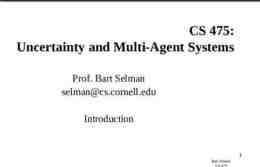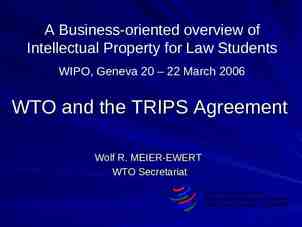What is disability? Module 1
21 Slides1.45 MB
What is disability? Module 1
Objective Introduce participants to the current human rights approach to disability and explain the evolution of other approaches Module flow How disability works Approaches to disability Charity approach Medical approach Consequences of charity and medical approaches Social approach Human rights approach Key principles of a rights-based approach Convention’s concept of disability Language and terminology
How disability works Personal factors Environmental factors Interaction Social participation
Some personal factors
Environmental factors Accessibility of environment (physical and informational) Hilly / flat Lack of accessibility Partial accessibility High levels of accessibility Legal/policy Socioeconomic Charity approach Anti-discrimination Supportive Measures (quotas.) Good enforcement Poor enforcement Rural / city / big city Rich / poor Strong negative attitudes and prejudice Positive awareness Open to change / closed Pro-poor Services Inclusive school/not inclusive Inclusive health care/not inclusive Inclusive youth centres/not inclusive Inclusive livelihood support/not inclusive Technical aids Community-based services Social support services Public / private Affordable
PERSONAL FACTORS Physical (inherent) The interaction Socioeconomic (individual impact) ENVIRONMENTAL FACTORS Accessibility Policy/legal Socioeconomic Interaction Services
Four approaches to disability Convention Time Charity approach Medical approach Social approach Human rights approach
Charity approach Charity house Poor people, we should help them, if we can and want to
Charity approach How this approach sees disability: Persons with disabilities are in a tragic situation Persons with disabilities cannot take care of themselves Persons with disabilities inspire compassion Persons with disabilities are objects of benevolence How this approach proposes to treat disability: They need our help, sympathy, charity Who is the duty bearer on disability issues: Benevolent persons, charity houses, homes, foundations, religious institutions Collect and give money to provide for persons with disabilities. The quality of the “care” is less important
Medical approach Rehabilitation centre Poor people, we should fix them, so they can participate.
Medical approach How this approach sees disability: Persons with disabilities need to be cured Persons with disabilities play the passive role of patients Persons with disabilities are considered abnormal Persons with disabilities are unable to live independently How this approach proposes to treat disability: Persons with disabilities need as much rehabilitation as possible to reach the best extent of normality, in order to access rights and participate in society Who is the duty bearer on disability issues: Doctors and health authorities Often health ministry
Consequences of charity/medical approaches Segregation Submission / Disempowerment Forced institutionalization Stigmatization Optional benevolence instead duty/rights Dependence Image disparagement Low self-esteem
Social approach We need to eliminate the barriers to enable the participation of persons with disabilities. Hospital School
Social approach How this approach sees disability: Disability is the result of a wrong way of organizing society: thus, persons with disabilities face bias and barriers that prevent their equal participation Disability is not an individual problem and mainly lies in the social environment that can be limiting or empowering depending on many factors Persons with disabilities can and should participate in society How this approach proposes to treat disability: Eliminate environmental barriers that constrain the participation of persons with disabilities, including attitudinal barriers Enable the participation of persons with disabilities in public policymaking Who is the duty bearer on disability issues: State, all ministries, society Make all public services and polices accessible and inclusive Ensure accessibility
Persons with disabilities are part of human diversity Being human has a broad spectrum of possibilities MANY WAYS OF WALKING MANY WAYS OF SEEING MANY WAYS OF THINKING MANY WAYS OF COMMUNICATING MANY WAYS OF INTERACTING Etc.
Human rights approach We, persons with and without disabilities, are part of the same society and we have the same rights and obligations Equal participation Co nv No enti w! on dis No cri nmi na tio n State
Human rights approach How this approach sees disability: Ensures full and equal enjoyment of all human rights to persons with disabilities, and promotes respect for their inherent dignity Focuses on equal opportunities, non-discrimination on the basis of disability and participation in society Requires authorities to ensure rights and not restrict them Views persons with disabilities as rights-holders How this approach proposes to treat disability: Enforce laws to ensure full inclusion in all social aspects (school, family, community, work, ) Apply policies to raise awareness Who is the duty bearer on disability issues: State, all ministries and society Respect equal recognition before the law Regulate the private sector
Key principles of a human rights approach Inclusion Participation Accessibility Nondiscrimination Respect for difference and diversity Equality of opportunities Respect for inherent dignity
The Convention’s concept of disability Disability is an evolving concept and results from the interaction between persons with impairments and attitudinal and environmental barriers that hinders their full and effective participation in society on a equal basis with others
Language and terminology Outdated Suggested Victim of Person with Suffering from Afflicted by Person with Invalid Person with disability Mentally handicapped Person with an intellectual impairment Mentally ill Person with a mental or psychosocial impairment Manic depressive Person with bipolarity Epileptic Person with epilepsy Spastic Person with cerebral palsy The blind Person who is blind, blind person, person with visual impairment The deaf Deaf person Disabled parking/disabled toilet Accessible parking/accessible toilet
Sources Convention on the Rights of Persons with Disabilities OHCHR, United Nations Department of Economic and Social Affairs and Inter-Parliamentary Union, From Exclusion to Equality: Realizing the Rights of Persons with Disabilities— Handbook for Parliamentarians on the Convention on the Rights of Persons with Disabilities and its Optional Protocol (HR/PUB/07/6) OHCHR, FAQ on the Convention on the Rights of Persons with Disabilities www.ohchr.org/EN/Issues/Disability/Pages/FAQ.aspx (accessed 2 August 2012)


























